The Calendar of the Yearly Festivals
125 125 Yahashira Shrine and Mihashira Shrine
Susanoo-no-Mikoto

Picture of the Kirin’s Head
Picture of the Shoujou’s Mask
| Date of the Festival | October-9 |
|---|---|
| Time for the Kirin Dance at the Shrine | 9 a.m. and 6 p.m. |
| Origin | Mid-Edo period |
| Characteristics | Designated as an Important Intangible Folk Cultural Property of Hyōgo Prefecture in 1972. |
| Area | Susanoo-no-Mikoto |
Introduction to the Shrine
Yahashira Shrine
The year of the shrine's founding is unknown. The shrine deity was divided and transferred from Yasaka Shrine in Yamashiro Province around the Genryaku era (1184–1185). The shrine was known as "Sanpōkōjin" during the Edo period. It was renamed to "Mihashira Shrine" in Meiji 1 (1868), and made one of the village’s shrines in October of Meiji 6 (1873).
■Deity of the Shrine
Susanoo-no-Mikoto
■cultural property
[Kirin Dance]
Designated as a Hyōgo Prefecture Important Intangible Cultural Property in 1978.
Designated as a National Important Intangible Folk Cultural Property in 2020.
Access to the Shrine
Shin-onsen Town 207-1, Mikata County, Hyōgo Prefecture (Yahashira Shrine) (MAP)
A ten-minute walk from ""Mio"" bus stop on the Mio Community Bus Line.
Mihashira Shrine
The year of the shrine's founding is unknown. The shrine deity was divided and transferred from Yasaka Shrine in Yamashiro Province around the Genryaku era (1184–1185). The shrine was known as "Sanpōkōjin" during the Edo period. It was renamed to "Mihashira Shrine" in Meiji 1 (1868), and made one of the village’s shrines in October of Meiji 6 (1873).
■Deity of the Shrine
Susanoo-no-Mikoto
■cultural property
[Kirin Dance]
Designated as a Hyōgo Prefecture Important Intangible Cultural Property in 1978.
Designated as a National Important Intangible Folk Cultural Property in 2020.
Access to the Shrine
Mio 54, Shin-onsen Town, Mikata County, Hyōgo Prefecture (MAP)
A ten-minute walk from ""Komio"" bus stop on the Mio Community Bus Line.
Related Information
Sites Associated with the Kirin Dances
Monuments around the Tottori Station
-
Wooden Benches
-
Sand Sculpture of Kirin
-
Stone Sculpture of Kirin
-
Tottori Toshogu in the Ouchidani Park
Tottori Toshogu was established by Mitsunaka Ikeda, a local lord, in the 17th century, and is a branch shrine of Nikko Toshogu. The shrine inherits the initial Kirin, which is now stored in the Tottori Prefectural Museum. During Gongen Matsuri, a festival in October, members of the Inaba Kirin Dance Club dance before the shrine’s deity, and a procession of a mikoshi (portable shrine) walks through to animate the festival.
-
The Imeitei Pioneer Memorial Gallery of Hamasaka
Imeitei is a gallery remodeled by Shichikamaya Yashiki (Shichikamaya Mansion) of the Mori family, who until lately ran a sake-brewery. It is a historical and folk gallery where visitors can trace the footsteps of the pioneers living around the Shin-onsen Town. The head of the Kirin from the Utsuno Shrine is displayed in the gallery. It is designated as the town’s cultural heritage.
-
Sora no Eki Park (Sky Station Park) at the Amarube Bridge
The origin of the Kirin from the Junisha Shrine, a shrine in adjacent to the Yoroi district, is the Kirin dance performed in the Iwami Town. This dance was a part of the inauguration of the Amarube Bridge at the end of the Meiji period. Visitors can see children’s drawings of the Kirin displayed in Sora no Eki at the Amarube Bridge and the park at the foot of the Amarube Crystal Tower. The roadside stations in vicinity are also worth sightseeing.



